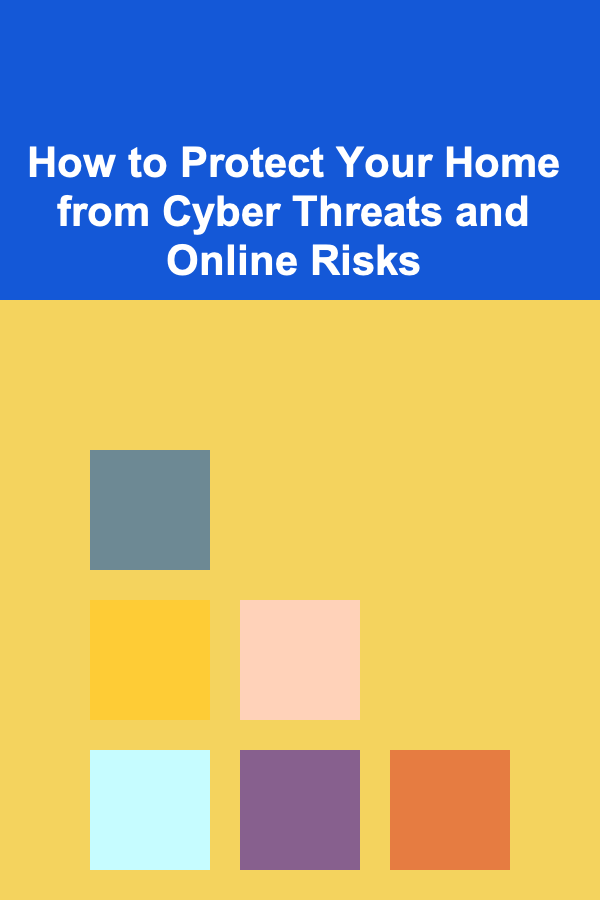
How to Protect Your Home from Cyber Threats and Online Risks
ebook include PDF & Audio bundle (Micro Guide)
$12.99$5.99
Limited Time Offer! Order within the next:

In today's increasingly digital world, protecting your home from cyber threats and online risks has never been more crucial. With the growth of smart homes, increased use of the internet, and the prevalence of online services, the potential for cybercriminals to exploit vulnerabilities in your personal and family life is ever-present. Cybersecurity is no longer just an issue for large corporations and government agencies; it is a matter of personal safety and privacy.
This article will delve into the key strategies and best practices for protecting your home from cyber threats and online risks. We will explore the different types of cyber threats, how they can affect individuals and families, and practical steps you can take to safeguard your home network and personal information.
Understanding Cyber Threats and Online Risks
Before diving into protective measures, it is essential to understand the types of cyber threats that are most commonly encountered by home users. Cyber threats can range from basic scams to more complex, sophisticated attacks that can lead to significant financial loss or privacy violations. Some of the most common cyber risks include:
1. Malware and Ransomware
Malware, short for malicious software, is any program or file designed to harm a computer system, steal data, or create other malicious outcomes. Ransomware, a type of malware, locks you out of your files or systems until you pay a ransom to the attacker. These types of attacks are increasingly common and can be devastating for individuals and businesses alike.
2. Phishing Attacks
Phishing is a technique in which attackers impersonate a trusted entity (such as a bank, online retailer, or social media platform) in order to steal sensitive information like passwords, credit card numbers, and login credentials. Phishing attacks typically occur through emails, text messages, or fake websites that look identical to legitimate sites.
3. Data Breaches
Data breaches occur when an unauthorized party gains access to sensitive data, such as personal details, financial information, or login credentials. Data breaches can happen when companies storing personal data are hacked, but individuals can also be at risk if their data is stolen through online accounts or insecure devices.
4. IoT Vulnerabilities
With the rise of the Internet of Things (IoT), many households now have smart devices such as thermostats, security cameras, smart speakers, and appliances connected to the internet. These devices often have weak security measures and can be exploited by cybercriminals to gain access to your network or personal data.
5. Identity Theft
Identity theft occurs when cybercriminals steal personal information to impersonate someone else, often for financial gain. This can involve opening new credit cards in your name, accessing your bank accounts, or making unauthorized transactions.
6. Social Engineering
Social engineering involves manipulating individuals into divulging confidential information. Cybercriminals may use psychological tricks to make you feel comfortable sharing sensitive data, such as pretending to be a trusted contact or using urgent requests to pressure you into providing information.
Why Home Cybersecurity is Essential
The rise of smart devices and connected homes has greatly increased the attack surface for potential cybercriminals. Many homeowners may overlook the security of their personal devices and networks, assuming they are safe because they aren't dealing with corporate or government-level systems. However, in reality, cybercriminals are increasingly targeting individuals and families, aware that they may have weaker security measures than large organizations.
The consequences of a cyberattack on your home can be severe. Ransomware can lock your personal files or compromise your home security cameras, while identity theft can result in financial loss, damaged credit, and emotional distress. These risks are compounded by the fact that many people don't know where to start when it comes to securing their online presence.
Steps to Protect Your Home from Cyber Threats
While no cybersecurity system is foolproof, there are several practical steps you can take to safeguard your home and mitigate online risks. Below are some of the most effective measures to protect yourself, your family, and your home network from cyber threats.
1. Secure Your Home Wi-Fi Network
Your home Wi-Fi network serves as the foundation for all your connected devices. A compromised Wi-Fi network can open the door for cybercriminals to access your personal data, including passwords and sensitive information. To secure your home Wi-Fi, follow these steps:
- Change the Default Router Password: Routers often come with default usernames and passwords that are easy for attackers to guess. Change these to something unique and strong.
- Use WPA3 Encryption: If your router supports WPA3 encryption (Wi-Fi Protected Access 3), enable it. WPA3 is the most secure encryption standard and offers better protection than its predecessors (WPA2 and WEP).
- Disable WPS (Wi-Fi Protected Setup): While WPS makes it easier to connect devices, it also makes your network more vulnerable to attacks. Disable it in the router settings.
- Create a Separate Network for Smart Devices: Many IoT devices have weak security, which can jeopardize the safety of your entire home network. Set up a separate Wi-Fi network for these devices to prevent them from being an entry point for cybercriminals.
- Use a VPN (Virtual Private Network): A VPN encrypts your internet traffic, making it harder for attackers to monitor your online activities or steal your data.
2. Use Strong, Unique Passwords
One of the simplest yet most effective ways to protect yourself from cyber threats is to use strong and unique passwords for all your online accounts. Weak passwords are a common target for attackers, and reusing passwords across multiple accounts makes it easier for them to access sensitive information.
- Avoid Using Default Passwords: Many people still use default or simple passwords, which can be easily guessed by cybercriminals.
- Use a Password Manager: A password manager can generate and store strong, unique passwords for each of your accounts, making it easier to maintain secure login credentials without having to remember them all.
- Enable Two-Factor Authentication (2FA): Two-factor authentication provides an extra layer of security by requiring you to provide a second form of identification (such as a code sent to your phone) in addition to your password.
3. Regularly Update Software and Devices
Cybercriminals often exploit known vulnerabilities in software and hardware to carry out attacks. Keeping your devices and software up to date is crucial in minimizing the risk of these exploits. Set your devices to automatically update whenever possible to ensure that you receive important security patches in a timely manner.
- Update Your Operating System: Both Windows and macOS regularly release updates to address security flaws. Make sure that your computer and smartphone operating systems are updated.
- Update Your Applications: Many apps, including web browsers, email clients, and productivity tools, frequently release security updates to address vulnerabilities. Always update apps to the latest version.
- Firmware Updates for IoT Devices: Smart home devices, such as thermostats, cameras, and speakers, often have firmware updates that improve security. Check for updates regularly and apply them as soon as they become available.
4. Be Wary of Phishing and Social Engineering Attacks
Phishing attacks are one of the most common ways that cybercriminals gain access to personal information. By tricking individuals into clicking on malicious links or opening infected email attachments, attackers can steal passwords, financial information, or even take control of your devices. To protect yourself from phishing:
- Be Skeptical of Unsolicited Emails: Always double-check the sender's email address and be cautious of messages that contain suspicious links or attachments.
- Hover Over Links: Before clicking on any links in an email or text message, hover your mouse over them to reveal the actual URL. This will help you identify whether the link is legitimate or malicious.
- Look for Red Flags: Phishing emails often contain grammatical errors, urgent language, or suspicious requests. If something feels off, don't engage with the message.
- Educate Your Family Members: Make sure everyone in your household, including children and older adults, understands the risks of phishing and how to spot potential threats.
5. Secure Your Smart Devices and IoT Network
With the growing number of IoT devices in homes today, it's critical to address the security risks they pose. Many smart devices come with weak security settings, and if left unsecured, they can provide cybercriminals with a backdoor entry into your network. To protect your IoT devices:
- Change Default Settings: Many smart devices come with default usernames and passwords. Make sure you change these to something more secure.
- Use a Guest Network for IoT Devices: As mentioned earlier, setting up a separate network for IoT devices can help isolate them from more sensitive devices, such as computers and smartphones.
- Disable Unnecessary Features: If your smart devices have features you don't use (such as voice commands or remote access), disable them to reduce the attack surface.
6. Monitor Your Accounts and Devices
Keep an eye on your online accounts and devices for any suspicious activity. Regularly checking your bank statements, credit card transactions, and other financial accounts can help you detect fraud early. Additionally, many security apps and services can alert you to potential threats or data breaches.
- Set Up Alerts for Financial Accounts: Most banks and credit card companies allow you to set up alerts for suspicious transactions. This can help you spot unauthorized charges quickly.
- Use Identity Protection Services: Consider using an identity protection service to monitor your personal information for any signs of theft or fraud.
7. Educate Your Family on Cybersecurity
Cybersecurity is not just an individual responsibility; it's something that should be a part of your entire household's daily routine. Make sure everyone in your home, from children to adults, understands the risks of online threats and knows how to protect themselves. Hold regular discussions about safe internet practices and encourage open communication if someone suspects they've encountered a threat.
Conclusion
As technology continues to evolve, so too do the threats that we face in the digital world. Cybersecurity is no longer a luxury, but a necessity for protecting your home, your family, and your personal information. By implementing the strategies outlined in this article -- from securing your Wi-Fi network to educating your family members -- you can significantly reduce the risk of cyberattacks and online risks.
Remember, cybersecurity is an ongoing effort. Stay vigilant, update your devices regularly, and remain aware of the latest threats to ensure that your home remains safe from cybercriminals.
Reading More From Our Other Websites
- [Home Budget 101] How to Make Your Home More Energy-Efficient and Save Money
- [Hiking with Kids Tip 101] Backpack Basics: Packing Essentials for Hiking with a Toddler
- [Polymer Clay Modeling Tip 101] Transform Your Home Décor: DIY Polymer Clay Wall Art Ideas
- [Organization Tip 101] How to Choose the Best Wood Rot Repair Products for Your Home
- [Organization Tip 101] The Cost-Effectiveness of Using a Foundation Crack Repair Kit
- [Personal Care Tips 101] How to Tailor Your Personal Care to Seasonal Changes
- [Home Renovating 101] How to Tackle a DIY Home Renovation Project Safely
- [Home Holiday Decoration 101] How to Organize Holiday Activities for Families
- [Survival Kit 101] Backpacking Survival Kit: What You Need to Stay Prepared in the Wild
- [Home Security 101] How to Choose the Best Home Security Cameras for Your Property

Creating Compelling Campaigns: Insights and Techniques for Advertising Managers
Read More
How to Plan a Themed Party Based on Your Favorite TV Show
Read More
How to Repurpose and Reuse Items for Home Decoration on a Budget
Read More
How to Use Garden Tool Belts for Convenience
Read More
How to Use Mindfulness for Digital Detox
Read More
How to Find Free Community Events
Read MoreOther Products

Creating Compelling Campaigns: Insights and Techniques for Advertising Managers
Read More
How to Plan a Themed Party Based on Your Favorite TV Show
Read More
How to Repurpose and Reuse Items for Home Decoration on a Budget
Read More
How to Use Garden Tool Belts for Convenience
Read More
How to Use Mindfulness for Digital Detox
Read More